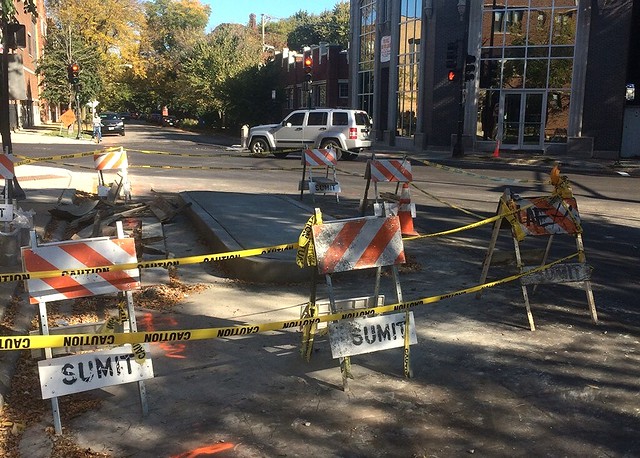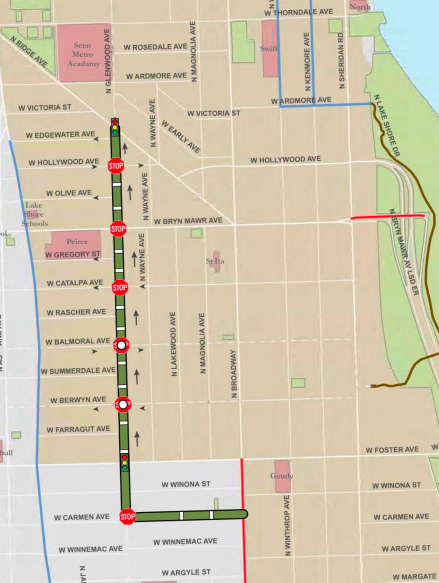
Thirty people gathered at the the Rivendell Theatre in Edgewater on Saturday morning to discuss the treatments currently being added to a short stretch of Glenwood Avenue to create a pedestrian- and bike-friendly "neighborhood greenway." These changes include a new contraflow bike lane and signage that will calm traffic and facilitate two-way bike traffic on this mostly one-way northbound stretch of Glenwood Between Carmen Avenue and Ridge Avenue.
Scanning the small crowd before the community meeting, I couldn’t help noting who had a bike helmet with them and who didn’t. Would the meeting have an us-versus-them feeling? Or was I preemptively denying each attendee’s individuality by mentally sorting them as cyclists or motorists before the meeting even started?
The meeting kicked off with a presentation by 48th Ward alderman, Harry Osterman. He began by describing Chicago as undergoing a “learning period,” as more people start riding bicycles in its streets. During the learning period, Osterman said, both people on bikes and people driving will need to learn how to coexist safely. He talked about wanting to bring together a working group, including people who bike and/or drive in the ward, to talk about sharing the streets.
The alderman explained that the one-way-northbound stretch of Glenwood between Foster Avenue and Ridge, about two-thirds of a mile, is already being used by southbound cyclists, including students biking home from Senn High School. He said that he understood how parking — especially parking removal — was a sensitive topic for the motorists in the room. Osterman went over the Glenwood route spot by spot, explaining how the changes would result in a net loss of exactly two parking spots.

When he finished speaking, the group had questions. Only a few of the people who spoke talked about the specifics of the proposed infrastructure improvements. One woman asked if the bike lane will make her liable if she hit a cyclist. Osterman replied that the lane would not affect liability. A man suggested the lane be built on Wayne Avenue, a wider street, instead of Glenwood.
However, most of the comments weren't about the specifics of the greenway. People wanted to talk about the general issues of speed, courtesy, and sharing the streets. In particular, as the comments began, expressed concerns from a driver's perspective. An elderly gentleman talked about an experience he had before he retired from driving. He described a close call during which several cyclists sped through an intersection. As a person who bikes, I appreciated hearing his point of view. I hadn't thought much about how older drivers might have a hard time reacting to cyclists on the road, although thinking about that made me equal parts sympathetic and nervous.
One woman said she wanted to be nice to bike riders by thanking them when they stop at intersections, but added that she almost never sees them stop. This set off chuckles among some of the attendees. Of course, as recent local video has shown, it's also very common -- and much more dangerous -- for people to blow through intersections while driving.
After the meeting Justin Haugens, a Rogers Park resident (and occasional Streetsblog freelancer) who often bikes through Edgewater, told me he was frustrated by what he heard. Haugens felt people were making inaccurate statements about the behavior of bike riders. For example, someone claimed that people regularly travel as fast as 30 mph while riding down side streets like Glenwood. “A driver’s perception of a biker’s speed is inaccurate,” he said.
During the community meeting, Haugens had shared his point of view with obvious emotion in his voice. He described what it felt to ride a bicycle while sharing the street with thousands of pounds of fast-moving metal. The other attendees listened quietly and respectfully. I wondered if hearing this would change drivers' attitudes or behavior.
“The remarks I made intended to humanize my experience while addressing their experience,” Haugens said. Watching the residents listen intently to his story made me think that the alderman’s idea of creating working groups of residents to talk through these issues might have value.
Too often, the conversation between people who drive and those who bike is about “finger-pointing,” Osterman said in a call “[There are] motorists in one corner, cyclists in the other corner, and pedestrians looking over their shoulder.” He said that the goals of the working group would be to “educate cyclists about what their responsibilities are, and also raise awareness of cyclist safety, pedestrian safety, and drive the message home that we all have to share the road together.”

How will this work? “We’re going to put a call out sometime this week or next,” Osterman said. “We’ll map out a strategy, and use the wintertime as a time to have some working groups on what we can do locally. And have some starter messaging for how we can all use the roads better come springtime, when the snow melts.”
Osterman discussed Sheridan Road in the ward as an example of a place where conflicts between pedestrians, bicyclists, and drivers have been an issue. This stretch of Sheridan is a high-speed four-lane, basically an extension of Lake Shore Drive, so it's not a safe place to bike, but there are many residences and retail destinations on the street. After neighbors, especially seniors, voiced concerns about being struck by bike riders on the sidewalk, an ordinance was passed to make sidewalk biking on this stretch punishable by a $250 fine – almost three times the $90 minimum penalty for driving on the sidewalk. “We’ve done enough with tickets being written and yelling at people,” the alderman noted.
Haugens thinks that the cyclist and motorist working group in in Edgewater may be a good idea. "It wouldn’t hurt," he said, adding that the best way for people who drive to gain perspective on the issues faced by Chicago cyclists would be for them to try biking on city streets themselves.
Two days later while walking on Glenwood, I spotted a woman biking south. I asked if she knew that a southbound bike lane would be installed on the street. She didn’t, but was happy to hear it. "That's great!" she shouted. She said that she regularly bikes south on Glenwood to pick her daughter up from kindergarten. The contraflow bike lane will legalize cyclist behavior that is already common, while making bike riders more visible to drivers.
Hopefully the winter working groups will help ward residents gain some empathy for other road users, and will lead to some progress towards street safety come springtime.





